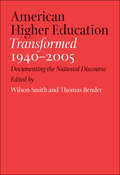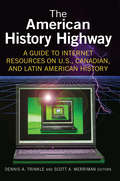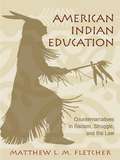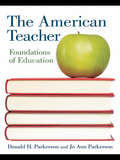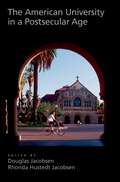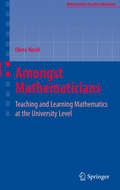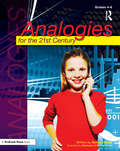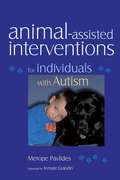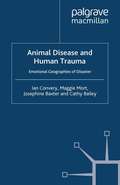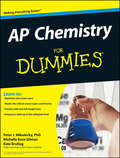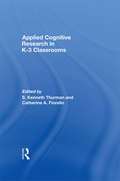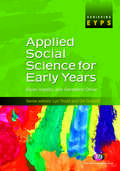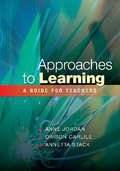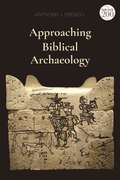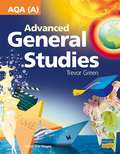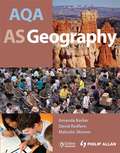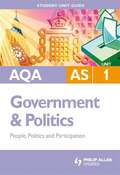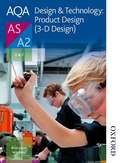- Table View
- List View
American Higher Education Transformed, 1940–2005: Documenting the National Discourse
by Thomas Bender Wilson SmithThis long-awaited sequel to Richard Hofstadter and Wilson Smith's classic anthology American Higher Education: A Documentary History presents one hundred and seventy-two key edited documents that record the transformation of higher education over the past sixty years.The volume includes such seminal documents as Vannevar Bush's 1945 report to President Franklin D. Roosevelt, Science, the Endless Frontier; the U.S. Supreme Court decisions in Brown v. Board of Education and Sweezy v. New Hampshire; and Adrienne Rich's challenging essay "Taking Women Students Seriously." The wide variety of readings underscores responses of higher education to a memorable, often tumultuous, half century. Colleges and universities faced a transformation of their educational goals, institutional structures and curricula, and admission policies; the ethnic and economic composition of student bodies; an expanding social and gender membership in the professoriate; their growing allegiance to and dependence on federal and foundation financial aids; and even the definitions and defenses of academic freedom. Wilson Smith and Thomas Bender have assembled an essential reference for policymakers, administrators, and all those interested in the history and sociology of higher education.
The American History Highway: A Guide to Internet Resources on U.S., Canadian, and Latin American History
by Dennis A. TrinkleThis brand new addition to the acclaimed "History Highway" series is essential for anyone conducting historical research on North, Central, or South America. Complete with a CD with live links to sites, it directs users to the best and broadest, most current information on U.S., Canadian, and Latin American history available on the Internet. "The American History Highway": provides detailed, easy-to-use information on more than 1,700 websites; covers all periods of U.S., Canadian, and Latin American History; features new coverage of Hispanic American and Asian American History; includes chapters on environmental history, immigration history, and document collections; all site information is current and up-to-date; includes a CD of the entire contents with live links to sites - just install the disc, go online, and link directly to the sites; and, also provides a practical introduction to web-based research for students and history buffs of all ages.
The American History Highway: A Guide to Internet Resources on U.S., Canadian, and Latin American History (History Highway Ser.)
by Dennis A. TrinkleThis brand new addition to the acclaimed "History Highway" series is essential for anyone conducting historical research on North, Central, or South America. Complete with a CD with live links to sites, it directs users to the best and broadest, most current information on U.S., Canadian, and Latin American history available on the Internet. "The American History Highway": provides detailed, easy-to-use information on more than 1,700 websites; covers all periods of U.S., Canadian, and Latin American History; features new coverage of Hispanic American and Asian American History; includes chapters on environmental history, immigration history, and document collections; all site information is current and up-to-date; includes a CD of the entire contents with live links to sites - just install the disc, go online, and link directly to the sites; and, also provides a practical introduction to web-based research for students and history buffs of all ages.
American Indian Education: Counternarratives in Racism, Struggle, and the Law
by Matthew L. FletcherAmerica Indian culture and traditions have survived an unusual amount of oppressive federal and state educational policies intended to assimilate Indian people and destroy their cultures and languages. Yet, Indian culture, traditions, and people often continue to be treated as objects in the classroom and in the curriculum. Using a critical race theory framework and a unique "counternarrative" methodology, American Indian Education explores a host of modern educational issues facing American Indian peoples—from the impact of Indian sports mascots on students and communities, to the uses and abuses of law that often never reach a courtroom, and the intergenerational impacts of American Indian education policy on Indian children today. By interweaving empirical research with accessible composite narratives, Matthew Fletcher breaches the gap between solid educational policy and the on-the-ground reality of Indian students, highlighting the challenges faced by American Indian students and paving the way for an honest discussion about solutions.
American Indian Education: Counternarratives in Racism, Struggle, and the Law
by Matthew L. FletcherAmerica Indian culture and traditions have survived an unusual amount of oppressive federal and state educational policies intended to assimilate Indian people and destroy their cultures and languages. Yet, Indian culture, traditions, and people often continue to be treated as objects in the classroom and in the curriculum. Using a critical race theory framework and a unique "counternarrative" methodology, American Indian Education explores a host of modern educational issues facing American Indian peoples—from the impact of Indian sports mascots on students and communities, to the uses and abuses of law that often never reach a courtroom, and the intergenerational impacts of American Indian education policy on Indian children today. By interweaving empirical research with accessible composite narratives, Matthew Fletcher breaches the gap between solid educational policy and the on-the-ground reality of Indian students, highlighting the challenges faced by American Indian students and paving the way for an honest discussion about solutions.
The American Teacher: Foundations of Education
by Donald H. Parkerson Jo Ann ParkersonThe American Teacher is a comprehensive education foundations text with an emphasis on the historical continuity of educational issues and their practical application in the classroom. Aspiring teachers enter the classrooms with an innate optimism, and the challenge of The American Teacher is to engage them and to provide meaningful direction to channel their idealism. By reconnecting individuals with their society, community, and workplace, this engaging text provides education students with a grounding in their profession and an understanding of how important social and political issues affect educational practice.
The American Teacher: Foundations of Education
by Donald H. Parkerson Jo Ann ParkersonThe American Teacher is a comprehensive education foundations text with an emphasis on the historical continuity of educational issues and their practical application in the classroom. Aspiring teachers enter the classrooms with an innate optimism, and the challenge of The American Teacher is to engage them and to provide meaningful direction to channel their idealism. By reconnecting individuals with their society, community, and workplace, this engaging text provides education students with a grounding in their profession and an understanding of how important social and political issues affect educational practice.
The American University in a Postsecular Age
by Douglas Jacobsen Rhonda Hustedt JacobsenFor much of the twentieth century, it was assumed that higher education was and ought to be a secular enterprise, but that approach no longer suffices. The culture has shifted, and contemporary college and university students are increasingly bringing religious and spiritual questions to campus. In response, college and university leaders are exploring anew the relationship between religion and higher education. The American University in a Postsecular Age grapples with key questions: --How religious or irreligious are faculty and students today? What level of religious literacy should be expected from students? --Can religion be allowed into the classroom without being disruptive? --Should colleges and universities help students reflect on their own faith? --Is religion antithetical to critical inquiry? --Can religion have a positive role to play in higher education? This is a state-of-the-art introduction to the national discussion about religion and higher education. Leading scholars and top educators express a wide spectrum of opinions that reflect the best current thinking. Introductory and concluding essays by the editors describe the postsecular character of our age and propose a comprehensive framework intended to facilitate ongoing conversation.
Amongst Mathematicians: Teaching and Learning Mathematics at University Level (Mathematics Teacher Education #3)
by Elena NardiThis book offers a unique perspective on ways in which mathematicians: perceive their students' learning; teach; reflect on their teaching practice. Elena Nardi achieves this by employing two fictional, yet entirely data-grounded, characters to create a conversation on these important issues. The construction of these characters is based on large bodies of data including intense focused group interviews with mathematicians and extensive analyses of students' written work, collected and analyzed over a substantial period.
Analogies for the 21st Century: Grades 4-6
by Bonnie L. RisbyThis is it! Here's the perfect venue for intermediate teachers to combine thinking skills and vocabulary development. Step into the 21st century with lessons that not only present students with analogies, but also provide them with instructions on how to best solve these verbal puzzles.An analogy is a comparison between two things. It points out the similarities or likenesses between things that might be different in all other respects. These exercises not only build thinking skills and make students more flexible and analytical; they also enhance vocabulary and writing skills.Intermediate students will get a jump on thinking skills and test taking strategies with these sure-to-please exercises. Whether this book is their first encounter with analogies or whether they are veterans with a great deal of experience, Analogies for the 21st Century gives them the tools they need in a fun-to-use format. It provides thinking strategies to help recognize the unique relationships between paired items and how these relationships can be replicated. Each lesson introduces new types of analogies, gives examples, and offers hints on solving the analogies. Vocabulary reflects today's culture, and helpful hints help students to build skills that will allow them to perform better on tests.This is one of a series of analogy books. For younger students, use First Time Analogies or Analogies for Beginners. For older students, use Thinking Through Analogies or Advancing Though Analogies. Grades 4-6
Analogies for the 21st Century: Grades 4-6
by Bonnie L. RisbyThis is it! Here's the perfect venue for intermediate teachers to combine thinking skills and vocabulary development. Step into the 21st century with lessons that not only present students with analogies, but also provide them with instructions on how to best solve these verbal puzzles.An analogy is a comparison between two things. It points out the similarities or likenesses between things that might be different in all other respects. These exercises not only build thinking skills and make students more flexible and analytical; they also enhance vocabulary and writing skills.Intermediate students will get a jump on thinking skills and test taking strategies with these sure-to-please exercises. Whether this book is their first encounter with analogies or whether they are veterans with a great deal of experience, Analogies for the 21st Century gives them the tools they need in a fun-to-use format. It provides thinking strategies to help recognize the unique relationships between paired items and how these relationships can be replicated. Each lesson introduces new types of analogies, gives examples, and offers hints on solving the analogies. Vocabulary reflects today's culture, and helpful hints help students to build skills that will allow them to perform better on tests.This is one of a series of analogy books. For younger students, use First Time Analogies or Analogies for Beginners. For older students, use Thinking Through Analogies or Advancing Though Analogies. Grades 4-6
Animal-assisted Interventions for Individuals with Autism
by Temple Grandin Merope PavlidesThis book looks at how therapies involving animals can be used to help individuals with autism to develop skills, including sensory and social skills, to manage challenging behaviors, and improve quality of life. Whether participating in therapeutic horseback riding, utilizing a trained service dog, visiting a dolphin therapy center, or simply experiencing companion animal therapy, people with autism can reap a multitude of benefits from interaction with furry, feathered, and finned friends. Merope Pavlides relates the success stories of different animal-assisted interventions, as well as noting the challenges of working with particular animal species. She also emphasizes the importance of tailoring interventions to the specific needs of the individual and of monitoring progress. With recommendations for resources and further reading, this book will be of great interest to people with autism, their parents, and the professionals who work with them.
Animal-assisted Interventions for Individuals with Autism (PDF)
by Merope Pavlides Temple GrandinThis book looks at how therapies involving animals can be used to help individuals with autism to develop skills, including sensory and social skills, to manage challenging behaviors, and improve quality of life. Whether participating in therapeutic horseback riding, utilizing a trained service dog, visiting a dolphin therapy center, or simply experiencing companion animal therapy, people with autism can reap a multitude of benefits from interaction with furry, feathered, and finned friends. Merope Pavlides relates the success stories of different animal-assisted interventions, as well as noting the challenges of working with particular animal species. She also emphasizes the importance of tailoring interventions to the specific needs of the individual and of monitoring progress. With recommendations for resources and further reading, this book will be of great interest to people with autism, their parents, and the professionals who work with them.
Animal Disease and Human Trauma: Emotional Geographies of Disaster
by I. Convery M. Mort J. Baxter C. BaileyMany disasters are approached by researchers, managers and policymakers as if they have a clear beginning, middle and end. But often the experience of being in a disaster is not like this. This book offers non-linear, non-prescriptive ways of thinking about disasters and allows the people affected by disaster the chance to speak.
AP Chemistry For Dummies
by Peter J. Mikulecky Michelle Rose Gilman Kate BrutlagGearing up for the AP Chemistry exam? AP Chemistry For Dummies is packed with all the resources and help you need to do your very best. This AP Chemistry study guide gives you winning test-taking tips, multiple-choice strategies, and topic guidelines, as well as great advice on optimizing your study time and hitting the top of your game on test day. This user-friendly guide helps you prepare without perspiration by developing a pre-test plan, organizing your study time, and getting the most out or your AP course. You’ll get help understanding atomic structure and bonding, grasping atomic geometry, understanding how colliding particles produce states, and much more. Two full-length practice exams help you build your confidence, get comfortable with test formats, identify your strengths and weaknesses, and focus your studies. Discover how to Create and follow a pretest plan Understand everything you must know about the exam Develop a multiple-choice strategy Figure out displacement, combustion, and acid-base reactions Get familiar with stoichiometry Describe patterns and predict properties Get a handle on organic chemistry nomenclature Know your way around laboratory concepts, tasks, equipment, and safety Analyze laboratory data Use practice exams to maximize your score AP Chemistry For Dummies gives you the support, confidence, and test-taking know-how you need to demonstrate your ability when it matters most.
Applied Cognitive Research in K-3 Classrooms
by S. Kenneth Thurman Catherine A. FiorelloThis volume summarizes research on important topics in cognitive research and discusses what must be done to apply this research in early elementary classrooms. Purposefully, it focuses on areas of cognitive research that have only recently begun to be studied in early elementary classrooms or that, based on educational and psychological theory, appear to have the greatest implications for early classroom learning Part 1, "Cognitive Applications in Early Elementary Classrooms," examines topics germane to the cognitive functioning of young children: working memory, executive functioning, theory of mind, phonemic awareness, and neuropsychological processing in the context of early elementary classrooms. Part 2, "Considerations for Further Research: Methods, Policy, and Issues," looks at practical and methodological issues of which applied cognitive researchers must remain cognizant: methodology, research designs, the gap between science and policy and means by which this gap can be diminished, and the need to consider how issues like ecological validity, individual differences, treatment integrity, and the relation between assessment and intervention are integral to designing applied cognitive research studies. The current emphasis on empirically supported treatments and research-based teaching and intervention in the schools, and legislation such as No Child Left Behind and the Individuals with Disabilities Education Improvement Act, have focused attention on the scientific basis of educational practice. However, applying research to the environment of the schools is not an automatic process. Bridging the gap has several prerequisites: researchers must attend to the ecological validity of their studies, universities must incorporate the results of research into their pre-professional training programs, and schools must support their inservice staff in developing new knowledge and skills. Applied Cognitive Research in K-3 Classrooms contributes strongly to these goals, not only by providing researchers, professionals, and graduate students in the fields of cognitive psychology, school psychology, educational psychology, educational research, and early elementary-level education with current understanding but also helping to set an agenda for further research that applies cognitive psychology in early elementary classrooms.
Applied Cognitive Research in K-3 Classrooms
by S. Kenneth Thurman Catherine A. FiorelloThis volume summarizes research on important topics in cognitive research and discusses what must be done to apply this research in early elementary classrooms. Purposefully, it focuses on areas of cognitive research that have only recently begun to be studied in early elementary classrooms or that, based on educational and psychological theory, appear to have the greatest implications for early classroom learning Part 1, "Cognitive Applications in Early Elementary Classrooms," examines topics germane to the cognitive functioning of young children: working memory, executive functioning, theory of mind, phonemic awareness, and neuropsychological processing in the context of early elementary classrooms. Part 2, "Considerations for Further Research: Methods, Policy, and Issues," looks at practical and methodological issues of which applied cognitive researchers must remain cognizant: methodology, research designs, the gap between science and policy and means by which this gap can be diminished, and the need to consider how issues like ecological validity, individual differences, treatment integrity, and the relation between assessment and intervention are integral to designing applied cognitive research studies. The current emphasis on empirically supported treatments and research-based teaching and intervention in the schools, and legislation such as No Child Left Behind and the Individuals with Disabilities Education Improvement Act, have focused attention on the scientific basis of educational practice. However, applying research to the environment of the schools is not an automatic process. Bridging the gap has several prerequisites: researchers must attend to the ecological validity of their studies, universities must incorporate the results of research into their pre-professional training programs, and schools must support their inservice staff in developing new knowledge and skills. Applied Cognitive Research in K-3 Classrooms contributes strongly to these goals, not only by providing researchers, professionals, and graduate students in the fields of cognitive psychology, school psychology, educational psychology, educational research, and early elementary-level education with current understanding but also helping to set an agenda for further research that applies cognitive psychology in early elementary classrooms.
Applied Social Science for Early Years
by Ewan Ingleby Mrs Geraldine OliverApplying social science subjects such as psychology, sociology, social policy and research methods to Early Years can help to raise standards and ensure good practice. These subjects inform much of the academic curriculum within many Early Years programmes and are subjects that make an important contribution to understanding children's behaviour, growth and development. The book identifies, analyses and assesses how social science enriches Early Years as opposed to regarding Early Years and social science as distinct. Each chapter imaginatively introduces the main learning objectives and includes formative activities, which apply social science to particular themes to aid students' cognitive skills.
Applied Social Science for Early Years (PDF)
by Mrs Geraldine Oliver Ewan InglebyApplying social science subjects such as psychology, sociology, social policy and research methods to Early Years can help to raise standards and ensure good practice. These subjects inform much of the academic curriculum within many Early Years programmes and are subjects that make an important contribution to understanding children's behaviour, growth and development. The book identifies, analyses and assesses how social science enriches Early Years as opposed to regarding Early Years and social science as distinct. Each chapter imaginatively introduces the main learning objectives and includes formative activities, which apply social science to particular themes to aid students' cognitive skills.
Approaches to Learning: A Guide For Teachers (UK Higher Education OUP Humanities & Social Sciences Education OUP)
by Anne Jordan Orison Carlile Annetta Stack"This book provides a really sound grounding in the theories that underpin successful teaching and learning. Without over-simplification it provides accessible introductions to the key learning theories with which teachers and students are likely to engage, and it has immense practical value."Professor Sally Brown, Pro-Vice-Chancellor, Leeds Metropolitan University, UKThis comprehensive guide for education students and practitioners provides an overview of the major theories of learning. It considers their implications for policy and practice and sets out practical guidelines for best pedagogical practice.The book can be read as a series of stand-alone chapters or as an integrated overview of theoretical perspectives drawn from the philosophy, psychology, sociology and pedagogy that guide educational principles and practice. Each chapter contains:An accessible introduction to each theoryA summary of key principlesCritical insights drawn from the theories discussed Examples and illustrations from contemporary research and practice Summary boxes that highlight critical and key points madePractical implications for education professionalsApproaches to Learning is an invaluable resource for students and practitioners who wish to reflect on their educational constructs and explore and engage in the modern discourse of education.
Approaching Biblical Archaeology
by Anthony J. FrendoAnthony J. Frendo introduces biblical students and scholars alike to the discipline of archaeology by explaining how the minds of professional archaeologists work, explaining what archaeologists seek, how they go about doing so, and how they interpret their data. Frendo shows those engaged in biblical scholarship how they can properly integrate biblical research with archaeological discoveries in a way that allows the bible and archaeology to be viewed and kept as distinct disciplines, the respective results of which, where relevant, may be integrated in productive discussion. Frendo also examines how the archaeology of the ancient Near East (particularly that of the southern Levant) has an essential bearing on how scholars can better appreciate the text of the bible, including its religious message. Frendo examines such matters as artefacts, stratigraphy and chronology, and archaeological reasoning. He also demonstrates that, whilst generally it is archaeology that casts light on the biblical text, at points biblical interpretation can help archaeologists to understand certain data.
AQA, A: Advanced General Studies (PDF)
by Eric Magee Trevor GreenThis coursebook has been written specifically to meet the needs of students following the AQA AS/A2 General Studies specification A, and provides thorough, carefully structured coverage of the subject content. AQA (A) Advanced General Studies has the following special features: A thematic approach A guide to essay structure Full coverage of subject content Data-sets, images, and texts Exam-style questions Draft responses and complete specimen essays. This is both a course book suitable for class or individual study, and a guide to preparation for unit tests in the subject. It is essential reading for all students following this specification. Answers to all questions and practice tests are provided in an accompanying Teacher Guide, which is available for purchase by teachers.
AQA AS: Student's Guide (PDF)
by Amanda BarkerComprehensive and accessible coverage for AQA AS Geography students. Written by senior examiners and leading authors, this best selling textbook give students the perfect platform to develop their understanding and skills, and prepares them for the unit exams. - In-depth coverage of the skills required for Unit 2: Applied Geography - Relevant and detailed case studies so students are fully informed - Free online resources, including sample exam-style questions with mark schemes and detailed commentaries are available at www.hodderplus.co.uk/philipallan
AQA AS Government & Politics Student Unit Guide: Unit 1 People, Politics and Participation (PDF)
by Paul FaircloughStudent Unit Guides are perfect for revision. Each guide is written by an examiner and explains the unit requirements, summarises the relevant unit content and includes a series of specimen questions and answers. There are three sections to each guide: Introduction - includes advice on how to use the guide, an explanation of the skills being tested by the assessment objectives, an outline of the unit or module and, depending on the unit, suggestions for how to revise effectively and prepare for the examination questions. Content Guidance - provides an examiner's overview of the module's key terms and concepts and identifies opportunities to exhibit the skills required by the unit. It is designed to help students to structure their revision and make them aware of the concepts they need to understand the exam and how they might analyse and evaluate topics. Question and Answers - sample questions and with graded answers which have been carefully written to reflect the style of the unit. All responses are accompanied by commentaries which highlight their respective strengths and weaknesses, giving students an insight into the mind of the examiner.
AQA Design & Technology: Product Design (3-D Design) AS/A2 (PDF)
by Will Potts Brian EvansSpecifically written to cover AQA's Product Design (3-D Design) specification, our student book takes a focused look at design and manufacturing processes, providing a visual insight into specific products and industries to help motivate students. Clear learning objectives at the start of each chapter, helping students focus on what they need to know. Key terms reinforce learning, providing definitions of key words that students need to be familiar with. Includes a range of activities that encourages your students to analyse materials and manufacturing processes used in product design.
